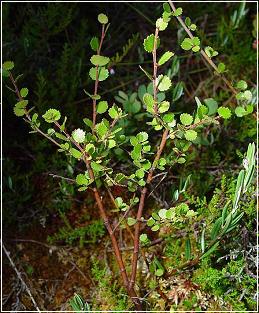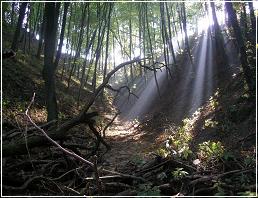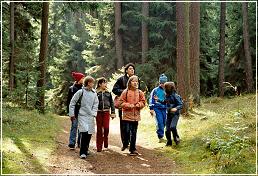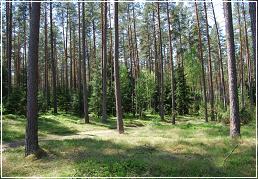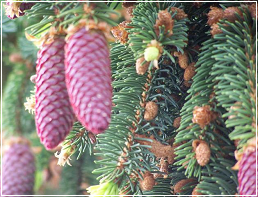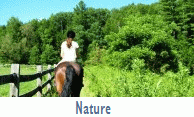|
The present-day plant cover of the Kuiavia-Pomerania region has undergone various changes throughout the history of the Earth. During the Tertiary, beside the plants occurring in the moderate climates, the Mediterranean and the Subtropical species thrived in the area. In the Pleistocene they were supplanted by Arctic flora and afterwards, with the receding of the continental glacier, there appeared tundra flora with characteristic mosses, lichens, willow clusters and the oak-leaved mountain avens. Today the scarce representatives of the plant cover of the period include the Dwarf Birch in the "Linje" peat bog reservation in the Commune of Dąbrowa Chełmińska in the Chełmno Land.
The holocene, i.e. the post glacial period, saw a frequent climate change. At first, it was preboreal – cold and dry – with pines and birch-trees predominating. It subsequently turned into the boreal one, which was dry and a bit warmer with pine, oak and hazel trees in the main. It was followed by the humid and warm Atlantic climate, which provided favourable conditions for the growth of mixed deciduous forests, oaks, lindens, elms and alders. The Atlantic period was succeeded by the dry and warm subboreal with pine forests predominating and eventually followed by the present-day subatlantic one, which was relatively humid and not very warm. It fostered the development of pine, spruce and beech trees. The climate characteristics of the past centuries have seriously influenced the formation of soil and water conditions.
|
|
Dwarf Birch (Betula nana) is a very rare bush. It grows up to 1 metre in height. In Poland it appears only in the reservation Linje near Toruń and in the moors of the Sudetes Mountains.
Dwarf birch is more abundant in the far north. It is a relic of the Ice Age, that is a plant that did not withdraw from these areas together with the Ice Sheet 11.5 thousand years ago.
|
The Kuiavian-Pomeranian forests constitute 5.4% of the whole afforested area in Poland and cover 22.3% of the region.
The major forest complexes are located along the largest rivers such as the Vistula, Brda, Drwęca, Noteć and Wda. The woodlands are made up of pine woods, including the Tuchola Forest, the Bydgoszcz Primeval Forest in the Valley of Toruń and the Włocławek forests, as well as deciduous woods, including the Brodnica Lakeland forests and Strzelno forests. The area of Górzno also abounds with considerable forest cover.
The region can boast two promotional forest complexes, i.e the Tuchola Forest (Polish: Bory Turcholskie) north-west of Toruń and the Gostynin-Włocławek Forest (Polish: lasy Gostynińsko-Włocławskie) south-east of Toruń, which are of ecological, educational and social significance. Both are included into a precise and uniform economic and protection program.
The woods, beside their protective and pro-educational functions, are important also for the community with regard to, for example, tourism, leisure activities and widely-understood ecological education. Tourists and holiday-makers exploring the region famous for its exceptional natural beauty pay increasingly more visits to the area, enjoying the local road network, numerous tourist land and water trails (canoeing trips), holiday resorts and boarding houses. It is noteworthy that the Tuchola Forest Inspectorate prepared an attractive educational offer in Woziwoda, with a leading Nature and Forest Education Centre and a couple of trails, including a well-developed educational forest trail and a sport and leisure one. Moreover, there are several nature reservations which serve sightseeing and educational purposes. Near the Brda River, there is a well-developed camping area, particularly attractive for kayakers. The Tuchola Forest Inspectorate prepared also an educational complex comprising the hall of ecological education, dendrological park and the educational trail called the “Deer Island” running through particularly valuable natural environment. With respect to the ecological education, Osie Forest Inspectorate closely cooperates with the Wda River Landscape Park. Joining in a common effort, they have marked out several educational trails such as the Zatoki trail, which is significantly concerned with forest issues.
The Gostynin-Włocławek Forest offers similar activities.
The woodlands are under the protection of the Regional State Forest Management in Toruń. |
|
|
 Suggested Reading: Suggested Reading:
|
Curent local weather in Toruń  | temp. 7.3° C |
|
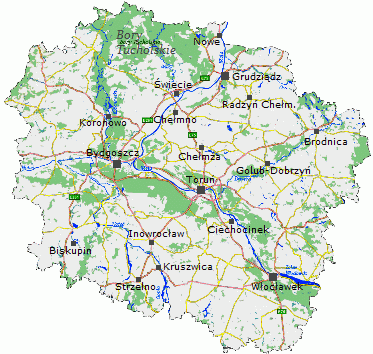
 Suggested Reading:
Suggested Reading: 











